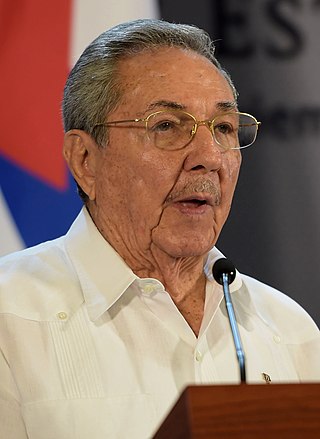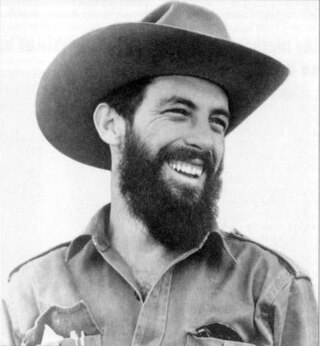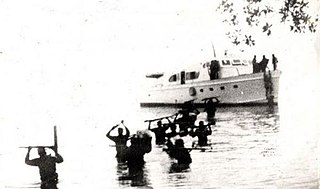Related Research Articles

The Cuban Revolutionary Armed Forces are the military forces of Cuba. They include army, navy, air force, and other paramilitary bodies including the Territorial Troops Militia, Youth Labor Army, and the Defense and Production Brigades, plus the Civil Defense Organization and the National Reserves Institution. All these groups are subordinated to the Ministro de las Fuerzas Armadas Revolucionarias.

Raúl Modesto Castro Ruz is a Cuban retired politician and general who served as the first secretary of the Communist Party of Cuba, the most senior position in the one-party communist state, from 2011 to 2021, and President of Cuba between 2008 and 2018, succeeding his brother Fidel Castro.

The Cuban Revolution was a military and political effort to overthrow the government of Cuba between 1953 and 1959. It began after the 1952 Cuban coup d'état which placed Fulgencio Batista as head of state and the failed mass strike in opposition that followed. After failing to contest Batista in court, Fidel Castro organized an armed attack on the Cuban military's Moncada Barracks on July 26, 1953. The rebels were arrested and while in prison formed the 26th of July Movement. After gaining amnesty the M-26-7 rebels organized an expedition from Mexico on the Granma yacht to invade Cuba. In the following years the M-26-7 rebel army would slowly defeat the Cuban army in the countryside, while its urban wing would engage in sabotage and rebel army recruitment. Over time the originally critical and ambivalent Popular Socialist Party would come to support the 26th of July Movement in late 1958. By the time the rebels were to oust Batista the revolution was being driven by the Popular Socialist Party, 26th of July Movement, and the Revolutionary Directorate of March 13.

Camilo Cienfuegos Gorriarán was a Cuban revolutionary. One of the major figures of the Cuban Revolution, he was widely considered second only to Fidel Castro among the revolutionary leadership.

Granma is a yacht that was used to transport 82 fighters of the Cuban Revolution from Mexico to Cuba in November 1956 to overthrow the regime of Fulgencio Batista. The 60-foot diesel-powered vessel was built in 1943 by Wheeler Shipbuilding of Brooklyn, New York, as a light armored target practice boat, US Navy C-1994, and modified postwar to accommodate 12 people. "Granma", in English, is an affectionate term for a grandmother; the yacht is said to have been named for the previous owner's grandmother.

Santa Clara is the capital city of the Cuban province of Villa Clara. It is centrally located in the province and Cuba. Santa Clara is the fifth-most populous Cuban city, with a population of nearly 250,000.

Juan Almeida Bosque was a Cuban politician and one of the original commanders of the insurgent forces in the Cuban Revolution. After the rebels took power in 1959, he was a prominent figure in the Communist Party of Cuba. At the time of his death, he was a Vice-President of the Cuban Council of State and was its third ranking member. He received several decorations, and national and international awards, including the title of "Hero of the Republic of Cuba" and the Order of Máximo Gómez.
The Cuban Revolution was the overthrow of Fulgencio Batista's regime by the 26th of July Movement and the establishment of a new Cuban government led by Fidel Castro in 1959.
Osmany Cienfuegos Gorriarán is a Cuban politician and older brother of Camilo Cienfuegos. He has served in various roles in the Cuban government.

Niquero is a municipality and town in the Granma Province of Cuba. It is located in the coastal region of the province, bordering the Gulf of Guacanayabo. Cape Cruz, the westernmost point of the province is located in this municipality.

The following outline is provided as an overview of and topical guide to Cuba:

Ramón M. Barquín was a Cuban military colonel and opponent of former President Fulgencio Batista. Barquín was jailed by the Batista government for leading a failed coup attempt in 1956. He later fled Cuba in 1960 following the 1959 takeover by Fidel Castro.
Norberto Collado Abreu was the Cuban captain and helmsman of the yacht Granma, which brought Fidel Castro and 81 other rebels to Cuba from Tuxpan, Veracruz, Mexico, in 1956. The 1956 landing of Castro from the Granma in eastern Cuba began the Cuban Revolution which resulted in the termination of President Fulgencio Batista's government in 1959.
The Day of the Cuban Armed Forces is a national holiday in Cuba celebrated annually on December 2 commemorating the landing of the Granma which brought the Castro brothers and their supporters from Mexico to Cuba to start their revolution against the Batista Regime. The event is marked by military parades, fireworks and concerts throughout the country.

Leopoldo Cintra Frías is a Cuban military and political leader. Cintra was the former Minister of the Revolutionary Armed Forces of Cuba.
Manuel Piti Fajardo Rivero was a Cuban revolutionary physician and fighter of the Rebel Army in the Sierra Maestra.
Armando Acosta Cordero,, known as Captain Erasmo Rodríguez, was a commander of the Cuban Rebel Army. From a very young age he participated in the struggle, with the Popular Socialist Party. He joined the Rebel Army in the Sierra Maestra and later joined Column 8 Ciro Redondo with which he contributed to liberate, different towns as well as his hometown.
Alla Taran was a Ukrainian violinist and pedagogue.
References
- ↑ http://www.cubadefensa.cu/?q=escuelas-camilo-cienfuegos.
{{cite web}}: Missing or empty|title=(help) - ↑ "Celebran aniversario 50 de las Escuelas Militares Camilo Cienfuegos". Granma.cu (in Spanish). Retrieved 2021-03-07.
- ↑ García, Beatriz Hernández. "Escuelas Militares". www.cmhw.icrt.cu (in European Spanish). Retrieved 2021-03-07.
- 1 2 3 "Creación de las escuela militares Camilo Cienfuegos". Fiscalía General de la República de Cuba (in Spanish). Retrieved 2021-03-07.
- 1 2 "Egresados más de 3 800 estudiantes de la Escuela Militar Camilo Cienfuegos". Escambray (in Spanish). 2016-09-23. Retrieved 2021-03-07.
- ↑ "Escuelas Militares Camilo Cienfuegos: Cantera de progreso". www.venceremos.cu. Retrieved 2021-03-07.
- ↑ "Escuela para la vida (+ fotos)". Escambray (in Spanish). 2018-09-24. Retrieved 2021-03-07.